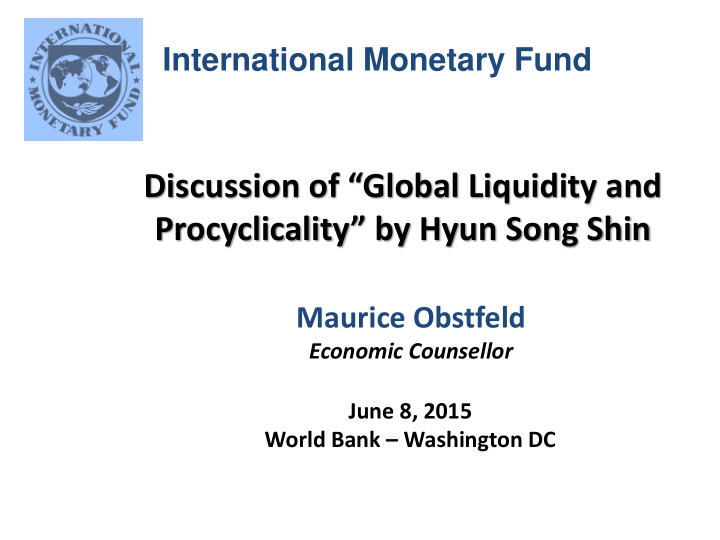



International Monetary Fund Discussion of “Global Liquidity and Procyclicality” by Hyun Song Shin Maurice Obstfeld Economic Counsellor June 8, 2015 World Bank – Washington DC
General Overview Main themes: U.S. financial conditions drive global conditions and risk taking by financial actors. U.S. dollar’s value is key barometer of risk taking. Euro and yen growing in importance? (I’m skeptical.) Evidence: Correlations with: • CIP deviations (my textbook, mea maxima culpa , is one that still says CIP holds, so I will focus on this one). • Dollar denominated bank lending. • Sovereign CDS. Why? Dollar’s unique role as an international currency. 1
Comment #1: The exchange rate-current account relationship is neither here nor there • CA deficits needn’t signal depreciation over any specific time frame. • Even in a world with only bonds and (uncovered) interest parity – making gross capital flows uninteresting – fall in world demand and rise in domestic demand lead to deficits but opposite exchange rate, output effects. • Currency movements are endogenous. • Life indeed is more complex when portfolio shifts an are independent source of disturbance to exchange rate. • Currency appreciation still needn’t be contractionary: 1. Effects on net worth via dollar liabilities (Shin). 2. Non-bond inflows (Blanchard et al., 2016). 2
Comment #2: CIP violations since 2008 are striking evidence of funding stress but we don’t yet understand them well Data show that since 2008, 1 + i US < ( F/S )(1 + i *). And this gap widens as dollar appreciates. 3
Comment #2 (continued) But what’s behind this? Ivashina et al. (2015) story: European banks have imbalance between desired dollar lending and lower-cost, dependable euro funding. So they swap euros into dollars and roll over – this creates a structural excess supply of forward dollars. Limits to arbitrage (liquidity, capital, market structure, etc.) explain why gap can persist. 4
Euro area banks’ EM lending important and mostly in dollars Substantial cross-border …with Euro area banks …but with the U.S. dollar bank claims on EMs… having a key role… being the dominant currency (BIS reporting banks’ cross-border (percent; share of cross-border bank (percent; share of cross-border bank claims on EMs 1/) lending to EMs by banking systems) lending to EMs by currency denomination) Total (USD trillion) U.S. Euro area Japan USD Euro Yen GBP Percent of GDP (RHS) U.K. Others 45 4 25 90 40 80 3.5 20 35 70 3 30 60 2.5 15 25 50 2 20 40 10 1.5 15 30 1 10 20 5 0.5 5 10 0 0 0 0 85 89 93 97 01 05 09 13 85 89 93 97 01 05 09 13 85 89 93 97 01 05 09 13 Sources: BIS Banking Statistics; and Cerutti, Claessens, and Ratnovski (2016). 5 1/ The sample of EMs include 49 large emerging markets
Comment #2 (continued) • In Ivashina et al. when euro banks are stressed, conventional USD funding retracts and they are forced to do more synthetic USD funding – swap demand effect. • Shin seems to put the locus of stress more on the suppliers of dollar swaps. • Of course, both forces could be at play. • Risk of counterparty failure? • We need a general-equilibrium picture. • “Real” channel? Dollar depreciation implies euro appreciation, which could hurt euro banks’ lending. • Open question: Why do CIP gaps differ by currency? 6
Comment #3: Is the Fed really all-powerful? Powerful global forces lie behind the natural real interest rate, and drive monetary policy worldwide. Dollar’s role important; but is it the central fact? Greenspan’s “conundrum” of mid-2000s may have revealed global influences. Some BIS thinking (C. Borio) downplays Wicksellian natural rate in favor of the primacy of “financing conditions.” But both interact in equilibrium, as Tobin’s general- equilibrium synthesis of stock-flow equilibrium showed. 7
Global real interest rates show a powerful common trend Global 10-year real interest rates 1/ 2/ (quarterly; percent) 8 Interquartile range U.S. Germany 6 4 2 0 16Q1 -2 90 92 94 96 98 00 02 04 06 08 10 12 14 Sources: IMF, Global Data Source ; Bloomberg L.P.; and Consensus Forecasts. 1/ Calculated as nominal 10-year bond yields minus 10-year ahead CPI inflation forecast (Consensus forecast). 2/ Sample includes Australia, Canada, France, Germany, Italy, Japan, Netherlands, New Zealand, Norway, Spain, 8 Sweden, Switzerland, United Kingdom, and United States.
Comment #4: Implications for EM monetary independence? A theme in recent literature is the monetary dependence of EMs, regardless of fix or float. But if 1 + i US < ( F/S )(1 + i *) for their currencies too (?), then ( F -1 /S -1 ) (1 + i US ) < 1 + i *. Does this gap widen too when dollar strengthens? If so, tighter U.S. monetary conditions may force the home central bank to raise i *, but cost of “synthetic” domestic- currency borrowing – borrow USD and swap into domestic currency – rises by less. Could provide a cushion, but likely limited, and also creates counterparty exposure. Need more research on EM hedged dollar borrowing. 9
Recommend
More recommend